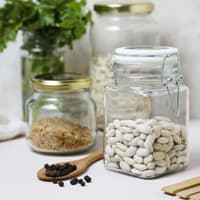
Dried fruit: healthy vitamins and nutritional values
Due to the drying process, dried fruit only has a water content of ten to 20 percent. This concentrates the nutrients it contains. It is true that heat-sensitive vitamins such as vitamin C suffer during drying. However, minerals such as potassium and magnesium are retained. What makes dried fruit even healthier is its high fiber content. The sugar content is also much higher due to the drying process compared to fresh fruit. That's why the rule of thumb when eating dried fruit is to only eat as much dried fruit as you would eat fresh fruit. This balances out the sugar consumption.
Dried fruit is better unsulphured
Drying also causes the fruit to lose its fresh color. Apricots, for example, tend to be brownish rather than golden yellow. Dried fruit is still sulphurized to counteract this change in colour. To do this, they are treated with sulphur dioxide (E 220). This can lead to headaches, nausea and diarrhea in sensitive people. It is better to choose unsulphurized goods. The list of ingredients will tell you this: If it says E 220, the fruit is sulphurized. Sulphur is prohibited in organic produce, as are the pesticide methyl bromide and the preservative sorbic acid. Organic fruit is often freeze-dried.
White coating
Dried fruit often has a whitish coating. It usually increases when the pack is opened. The whitish layer is crystallized sugar. This is not a defect, but actually a sign of quality. The fruit's own sugar comes out more when the pack is open and the residual moisture evaporates. Nevertheless, you should take a close look: If the coating smells sour and the fruit is mushy, be careful. Then the fruit is spoiled.
With figs, you should open each fruit as a precaution to inspect it for black spots (black mold). Seal opened packages tightly or transfer the fruit to a storage container. Dried fruit will keep for several weeks if stored in a cool, dry place.






